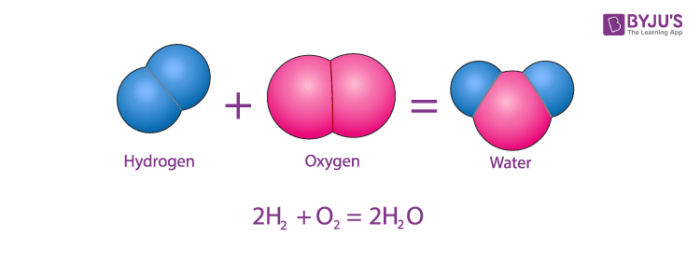Atoms and molecules serve as the foundational units that compose all matter in the universe. Their significance extends far beyond mere components of physical entities; they epitomize the intricacies of interaction and the underlying symmetries of nature itself. Understanding their scientific explanation invites us to embark on an intellectual journey through the realms of atomic theory, molecular formation, and the ensuing implications for our understanding of the material world.
At the crux of the scientific inquiry into atoms lies the definition of the atom as the smallest indivisible unit of an element, characterized by a nucleus surrounded by a cloud of electrons. The nucleus, comprising protons and neutrons, is a composite entity bound by the strong nuclear force, a fundamental interaction that allows stability within this minuscule cosmic architecture. Protons possess a positive charge, while neutrons are neutral; together, they forge the nucleus at an astounding density. Consequently, the atom’s formidable structure is not merely a random amalgamation but rather a beautifully orchestrated arrangement governed by the laws of quantum mechanics.
The historical evolution of atomic theory marks an essential chapter in the annals of science. Initial musings by ancient philosophers, such as Democritus, laid the groundwork for the notion that matter is constituted of discrete particles. However, it was not until the early 19th century that John Dalton formalized atomic theory, proposing that each element consists of unique atoms with distinct weights. This paradigm was further refined by scientists such as J.J. Thomson, who identified the electron, and Ernest Rutherford, who elucidated the nuclear structure of atoms through his gold foil experiment.
In the 20th century, advancements in quantum mechanics provided a more nuanced understanding of atomic behavior. The wave-particle duality of electrons, as espoused by the de Broglie hypothesis and Heisenberg’s uncertainty principle, posited that electrons do not merely orbit the nucleus in defined paths; rather, they exist in probabilistic clouds known as orbitals. This revolutionary shift in perspective prompted a re-evaluation of atomic interactions and led to the formulation of quantum chemistry, which addresses the behaviors of electrons in more complex molecules.
Transitioning from the individual atomic unit to the ensemble of atoms, we encounter molecules—the aggregate of two or more atoms bonded together through various types of interactions. The formation of molecules is intrinsically tied to the concept of chemical bonds, which include covalent, ionic, and metallic bonds. Covalent bonds arise from the sharing of electron pairs between atoms, fostering a robust connection that underpins innumerable organic and inorganic compounds. In contrast, ionic bonds emerge from the electrostatic attraction between charged ions, often manifesting in crystalline structures. Metallic bonding further complicates the landscape by allowing electrons to pool in a “sea,” imparting unique physical properties to metals.
The inherent stability of these molecular structures often correlates with the octet rule, which states that atoms tend to prefer having eight electrons in their outermost shell, leading towards a state of maximum stability. This principle illuminates why prevalent compounds such as water (H₂O) and carbon dioxide (CO₂) take on distinct geometries and functionalities that are critical to biological life and ecological balance. For instance, the bent structure of water not only facilitates its liquid state at ambient temperatures but also endows it with exceptional solvent properties necessary for biochemical reactions.
As we delve deeper into molecular dynamics, we uncover the implications of molecular interactions on larger physical phenomena. The interplay between molecules leads to the vast array of states of matter: solids, liquids, and gases. The kinetic molecular theory provides insights into how molecules behave under varying temperature and pressure conditions, culminating in transitions that are pivotal for both everyday experiences and industrial applications. Furthermore, phenomena such as hydrogen bonding in water molecules elucidate the nuances of intermolecular forces that are responsible for unique physical properties, including its high specific heat capacity and surface tension.
In recent decades, the advent of advanced imaging techniques—such as scanning tunneling microscopy—has illuminated the obscure world of atoms and molecules, allowing scientists to visualize molecular structures and interactions with unprecedented clarity. As these tools continue to evolve, the ability to manipulate atoms and molecules with atomic precision may redefine the boundaries of material science and nanotechnology.
The implications of understanding atoms and molecules extend far beyond laboratory confines; they resonate through disciplines such as pharmacology, biochemistry, and materials science. The synthesis of novel compounds aimed at medical therapeutics or the engineering of materials with desirable properties exemplify the keystone role that atomic and molecular comprehension occupies in contemporary scientific exploration.
In summation, the scientific explanation for atoms and molecules encapsulates a profound narrative that merges historical insights with modern quantum theories, engendering a versatile framework for understanding the universe. As the fabric of existence is woven through atomic interactions, every phenomenon—whether minuscule or monumental—is fundamentally linked to these elemental units. To explore the realms of atoms and molecules is to uncover the very essence of matter, prompting us to rethink our relationship with the material world and inspiring a relentless pursuit of knowledge in the magnificent tapestry of science.












